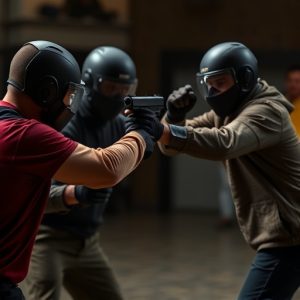Safeguarding Seniors: Non-Lethal Weapons & Discharge Prevention Training
Accidental discharge of non-lethal self-defense weapons among seniors is a significant concern, but…….
Accidental discharge of non-lethal self-defense weapons among seniors is a significant concern, but these tools can greatly enhance their independence and safety. With proper training, maintenance, and selection of user-friendly devices like pepper spray, personal alarms, and stun guns, seniors can protect themselves while reducing the risk of accidental discharges. Prioritizing ergonomic design and conducting user testing ensures these weapons cater to seniors' unique needs and physical limitations. Workshops and regular practice sessions empower older adults to use non-lethal self-defense weapons responsibly, fostering their confidence and security without resorting to lethal force.
Accidental discharge of firearms is a significant concern for seniors, posing both physical risks and emotional trauma. This article explores comprehensive strategies to enhance senior safety through non-lethal self-defense weapons and innovative design. We delve into the causes and potential dangers, emphasizing the critical role these tools play in empowering individuals to protect themselves. By combining practical training with user-friendly weapon designs, we aim to provide insights into effective accidental discharge prevention mechanisms tailored for seniors.
- Understanding Accidental Discharge: Causes and Risks for Seniors
- The Role of Non-Lethal Self-Defense Weapons in Senior Safety
- Design Considerations for User-Friendly, Safe Senior-Focused Weapons
- Training and Education: Empowering Seniors to Protect Themselves
Understanding Accidental Discharge: Causes and Risks for Seniors
Accidental discharge, especially in the context of non-lethal self-defense weapons for seniors, refers to the unauthorized or unintentional activation of a device designed to protect. Seniors, despite their advanced age, may find themselves in situations that necessitate personal safety measures. However, due to physical limitations or reduced reflexes, traditional self-defense tactics might not be effective. This is where non-lethal self-defense weapons come into play as a crucial tool for them to deter potential threats and maintain their independence.
The causes of accidental discharge can vary, ranging from mishandling of the weapon to environmental factors like tremors or poor visibility. Seniors need to be aware of these risks and understand how to handle such devices safely. Proper training, regular maintenance, and choosing weapons with reliable safety mechanisms are essential steps in preventing accidental discharges. By doing so, seniors can arm themselves with peace of mind, knowing they have a means of non-lethal self-defense at their disposal while minimizing the chances of unwanted incidents.
The Role of Non-Lethal Self-Defense Weapons in Senior Safety
In recent years, there’s been a growing recognition of the need to enhance senior safety, especially in scenarios involving potential threats or attacks. Non-lethal self-defense weapons have emerged as a crucial tool for empowering seniors to protect themselves while avoiding fatal consequences. These weapons, designed with less than lethal force in mind, offer a range of options suitable for older adults who may have mobility challenges or specific medical conditions that require caution in their response to danger.
Non-lethal self-defense tools cater to various needs and abilities, from pepper spray designed for close-range defense to personal alarms and stun guns with less impact. Their effectiveness lies not only in the level of harm they prevent but also in providing seniors with a sense of security and independence. This is particularly important given that elderly individuals often live alone and may be vulnerable to intrusions or assaults. By arming themselves with non-lethal options, seniors can confidently navigate their surroundings, knowing they have a means of self-protection tailored to their unique circumstances.
Design Considerations for User-Friendly, Safe Senior-Focused Weapons
When designing non-lethal self-defense weapons for senior citizens, user-friendliness and safety should be paramount. The physical limitations and reduced mobility often associated with aging require special consideration in weapon design to ensure they are accessible and easy to use. Ergonomic grips, lightweight materials, and simple, intuitive triggers or mechanisms can make a significant difference in the handling of such weapons by seniors. For instance, air-powered or electronic stun guns could be more suitable alternatives to traditional firearms due to their reduced recoil and ease of operation.
Furthermore, incorporating safety features such as automatic locks, trigger disablers for non-threatening situations, and sensors that detect unintended movements can prevent accidental discharges. User testing and feedback from senior communities are essential to validate the effectiveness and usability of these design considerations. Tailoring self-defense options to meet the specific needs and capabilities of seniors not only enhances their personal safety but also promotes their independence and peace of mind.
Training and Education: Empowering Seniors to Protect Themselves
Training and Education play a pivotal role in accidental discharge prevention, especially for seniors considering non-lethal self-defense weapons. Many older adults are looking for ways to protect themselves while maintaining their independence, and proper education is key. Workshops and seminars focused on safety measures, weapon handling, and de-escalation techniques can empower seniors to use these tools effectively and responsibly.
By learning about different types of non-lethal self-defense weapons, their range, and the necessary precautions, seniors can make informed decisions. Regular practice sessions under professional guidance ensure they are comfortable and confident using the devices in emergency situations. This proactive approach not only enhances personal safety but also builds a sense of security among older individuals who wish to protect themselves without resorting to lethal force.
Accidental discharge prevention mechanisms are vital for ensuring the safety of seniors, especially when considering non-lethal self-defense weapons as a viable option. By understanding the causes and risks associated with such incidents, we can design user-friendly tools that cater to this demographic’s unique needs. Training and education play a crucial role in empowering seniors to protect themselves effectively while mitigating potential hazards. Incorporating these strategies fosters a safer environment for seniors, promoting their independence and peace of mind. Non-lethal self-defense weapons for seniors represent a game-changer in personal safety, offering a responsible approach to their protection.


